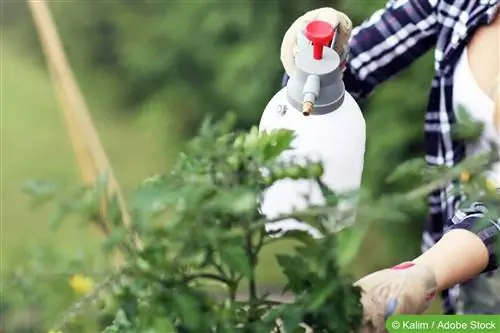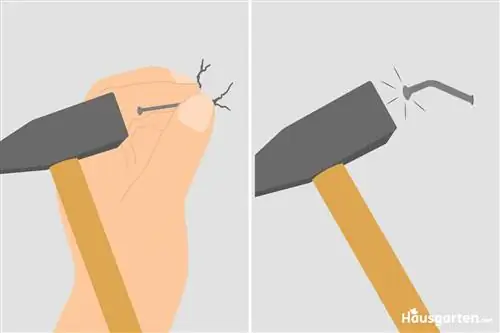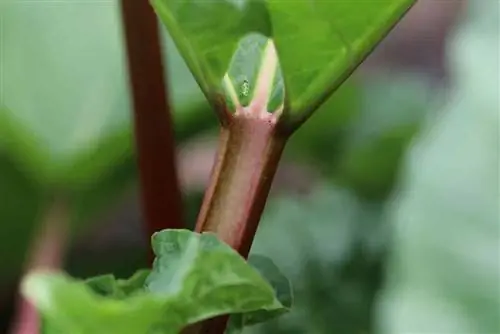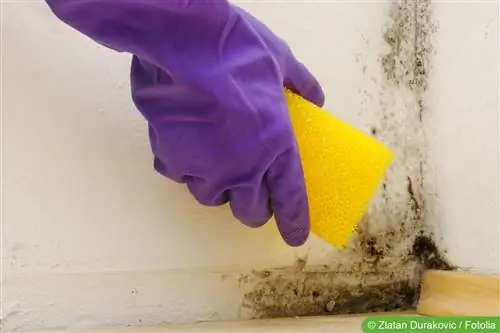- Author admin [email protected].
- Public 2023-12-17 03:39.
- Last modified 2025-01-24 12:45.
Not every pest infestation is really worth fighting and there are often alternatives that are biologically harmless. Gardeners can do a lot when planting a garden to keep plants he althy. This can be done, for example, by selecting plant varieties that are less susceptible to certain diseases and pests. It is also important to create favorable location and soil conditions. And last but not least, crop rotation and the right mixed culture protect plants in the kitchen garden against pests and diseases. Sometimes it is still necessary to use pest-free products in the home garden.
What exactly is pest-free?
Pest-free are products from various manufacturers that act as plant protection products against sucking or eating pests on plants. The active ingredients in Pest Free are acaricides and insecticides. Acaricides are pesticides or biocides used to control biting and sucking insects. Both groups of substances are not only fatal in direct contact with the pest, but also penetrate the plant after application and remain there for a long time. The plant can absorb the active ingredient either through the leaves or through the roots. That's why Pest Free is available both as a spray and as a watering solution. Common active ingredients in pest free are:
- Abamectin
- Acetamiprid
- Azadirachtin (Neem products)
- Pyrethine (Pyrethrum)
- Thiacloprid
These substances have a neurotoxic effect on insects. The insects' nervous system (both motor and sensory nerves) no longer works properly and the pests die.
Which pests are controlled?
A whole range of sucking and eating insects and their larvae are among the pests that can be controlled with Pest Free. Depending on which active ingredient or combination of active ingredients is used, these are, for example:
- Aphids
- Leaf-eating beetles and their larvae
- Soil pests (such as black weevil larvae)
- Boxwood moth
- Frost tensioner
- Web Moths
- Leaf miners
- Scale insects
- Butterfly larvae
- mealybugs and mealybugs
- Sitka spruce louse
- Spider mites
- Thrips
- Whiteflies
- Wasp larvae (sawfly and sawfly)
- Cicadas
Tip:
Since not all varieties are pest-free against all pests, the pest must be clearly identified. Our specialist advisors can tell you which product works best.
Before use
If a pesticide is the only way out in the fight against pests, there are various options for application. Depending on which pests parasitize on which plant and whether the plant is indoors or outdoors, different application methods make sense. Pest-free is available in the following variants:
- as a ready solution to spray on the leaves and flowers
- Spray agent that must first be mixed with water
- as a product that is administered via the irrigation water
- so-called combination sticks that are inserted into the soil and also contain fertilizer
- Combi granulate: like combination sticks, just different dosage form
Read and follow instructions for use
The manufacturer's instructions for use contain everything that is necessary for the correct and safe use of Pest Free. The following points should be particularly noted:
- personal protective measures
- Dosage
- Waiting time until harvest (for fruit and vegetables)
Check weather conditions
Since pest-free only works effectively in optimal weather conditions, it is important to check in advance whether the weather conditions are suitable for using pest-free. There are a few points to consider, especially when it comes to spray agents:
- Do not use if rain is expected (then the active ingredients cannot have sufficient effect)
- it should be as calm as possible (so the spray mist doesn't drift away)
- Minimum temperature: Some of the products can be used at a temperature of 5 degrees, others only develop their optimal effect at around 15 degrees
- do not use from a daytime temperature of 25 degrees or direct sunlight
- Application outdoors only from March to September
Checklist for dealing with pest-free
1. Expert handling
Everyone who uses an insecticide such as Pest Free must familiarize themselves in advance with the competent use of the product and any special features when handling it. That's why all Pest Free manufacturers include detailed instructions for use, which should be read carefully before use and strictly followed during use. This is the only way to achieve an effective effect and prevent damage to people, animals and the environment.
2. Appropriate protective clothing
The obligation to wear protective clothing begins when filling and decanting as well as when preparing the pest-free preparation. The motto here is: Avoid any unnecessary contact with pest-free! In principle, the following protective equipment must be worn for use:
- sturdy, closed footwear (rubber boots for large areas)
- long clothing (on legs and arms)
- wear waterproof disposable or universal gloves
3. Purchasing pest-free
Purchasing large quantities of pest-free products is not in the interest of plant protection, even if this sometimes seems sensible for price reasons. The purchase should always be tailored to the situation. Only plant protection products that explicitly declare this on the packaging are permitted for home and allotment gardens.
4. Filling and cleaning devices
When filling watering cans or sprayers, always ensure that the pest-free solution does not accidentally get onto paved surfaces or into the sewage system. The same applies to cleaning the equipment, which is rinsed several times with clear water after use. Since the soles of your shoes can also be contaminated with the product if Pest Free is applied to large areas, it is recommended to wear rubber boots, which must be washed off after use.
Tip:
It is best to clean equipment on site with a garden hose. The washing water is poured onto the soil over the roots of the treated plants. Do not rinse over the treated leaves.
Proper application
If all protective measures have been taken in advance and the instructions for use have been read carefully, it is now time to apply Pest Free correctly.
1. Spray solution
Spray solutions are either available ready to use or must be mixed with water. In both cases, the specified dosage quantities must be strictly adhered to.
- only prepare the required amount of spray solution
- Check weather conditions
- best used in the morning or late afternoon
- choose a rain-free day without particularly hot temperatures
- work on windless days if possible
- do not spray on windy days
- pay attention to the wind direction (always spray with the wind direction)
- spray slowly and evenly over the plants
- only spray actually infected plants
- maintain sufficient distance from bodies of water (at least 5 m when there is no wind)
- Keep children and pets out of reach when using
Tip:
The motto “A lot helps a lot” can have fatal consequences. Therefore, the quantities stated on the packaging must be adhered to exactly.
2. Pouring solutions
Dilute the product with water or dissolve in water according to the instructions for use. Be sure to avoid skin contact. After stirring thoroughly, the solution can be applied directly to the root ball of the affected plant using a watering can. The active ingredients are absorbed by the plant and work against the pests after about two to four days.
3. Combination sticks
So-called combination sticks contain, in addition to the actual pest-free, fertilizer to strengthen the plants against pests at the same time. Depending on the manufacturer, the approximately 2 cm long sticks are supplied with an inserter with which the sticks are inserted deep into the roots of the affected plant without contact with the skin. Otherwise, be sure to wear gloves.
- are particularly suitable for houseplants and balcony plants
- not suitable for large-scale use
- dissolve due to the moisture in the soil
- pour well after adding
- Active ingredients are absorbed through the roots
- Effect takes effect after 2-4 days
- lasts up to 8 weeks
- can be used all year round
Document the application
Sometimes it is necessary to use Pest Free again. Depending on the active ingredient, Pest Free can be sprayed a maximum of two to three times a year during the growing season. In order to be able to better estimate the waiting times until harvest and the frequency of treatment, it makes sense to document when which agent was used.
Storage
If pest-free is not used straight away or if there are leftovers, it must be ensured that the product does not pose a danger to people or the environment. Pest Free should therefore always be kept locked and out of the sight and reach of children and animals. In addition, it should be stored pest-free in the original packaging including instructions for use. Filling into unlabeled containers or even beverage bottles poses a risk of accidents that should not be underestimated. The storage location should be protected from frost and high temperatures.
Disposal
Empty pesticide bottles and containers are rinsed clean. The rinse water must not enter the sewage system as the active ingredients are dangerous for aquatic organisms and fish. Therefore, the diluted rinse water is best poured onto the area that has previously been treated with pest free. Unused residues should be taken to the hazardous waste collection point (recycling yard or environmental vehicle). Unless otherwise stated on the packaging, pest-free has a shelf life of around two years.
Conclusion
Using Pest Free is not really difficult. However, the product should always be used carefully and with caution. This includes, for example, the clear identification of the pest and the search for possible biological alternatives. Anyone who uses pest-free should always read the instructions for use carefully in advance and follow all instructions exactly. This is the only way pest-free can work effectively and guarantee safe use for people, animals and the environment.






